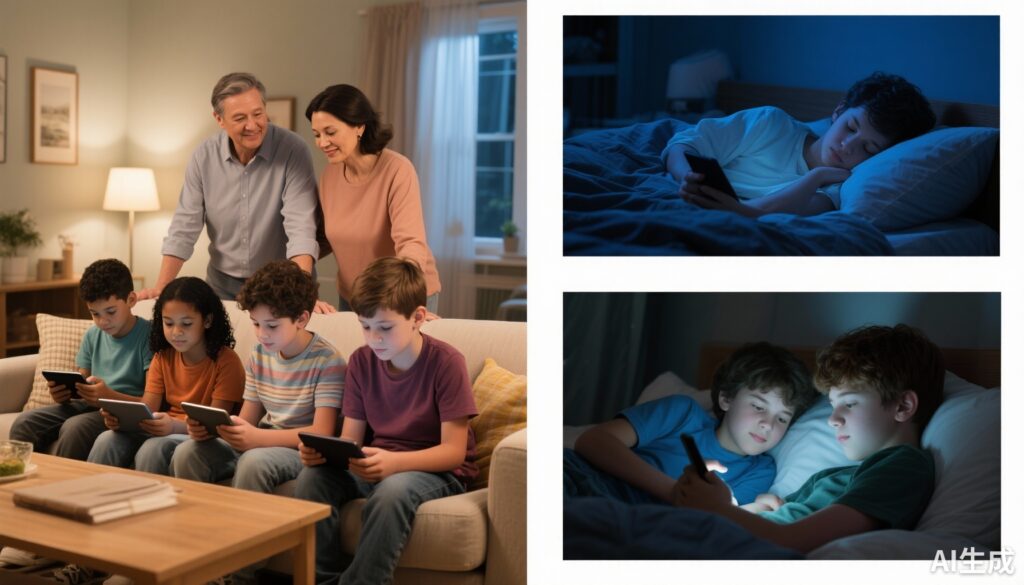Highlight
– Greater parental monitoring is prospectively associated with better adolescent sleep quality.
– Family conflict and parental psychopathology predict later chronotype, delayed sleep timing, and poorer sleep quality.
– Adolescent screen use partially mediates the link between parental factors and sleep outcomes.
– Emotional regulation mediates the relationship between parental factors and sleep quality but not other sleep domains.
– The association between parental warmth and chronotype is stronger in girls, indicating sex-specific moderating effects.
Study Background and Disease Burden
Adolescence is a critical developmental period marked by profound biological and psychosocial changes that frequently disrupt sleep patterns. Sleep problems, including insufficient duration, poor quality, irregularity, and delayed timing, are highly prevalent among adolescents worldwide and carry significant consequences for mental health, academic performance, and physical well-being. Poor sleep is linked with depression, anxiety, obesity, and impaired cognitive function.
Despite broad recognition of sleep problems in adolescence, interventions to improve sleep remain limited and often nonspecific. Parental influences are a potentially modifiable factor that may shape adolescent sleep behaviors and physiology through family environment, emotional support, and behavioral modeling. Yet, the prospective impact of modifiable parental factors such as monitoring, warmth, family conflict, and parental psychopathology on adolescent sleep trajectories is not well-characterized.
Moreover, the pathways underpinning parental influences—specifically whether adolescent screen use and emotional regulation mediate these associations—remain to be elucidated. Understanding these mechanisms and how they differ by sex during early adolescence can provide foundational knowledge to tailor evidence-based, family-centered interventions aimed at optimizing adolescent sleep health.
Study Design
This preregistered prospective cohort study utilized data from the Adolescent Brain Cognitive Development (ABCD) Study, a US-based, nationally representative sample. Sleep and parental factor-related data were collected at three time points: wave 1 (ages 9-11), wave 2 (ages 12-13), and wave 3 (ages 13-14), spanning June 1, 2016, to October 15, 2018. The analysis included 3,419 youths with sleep data available at wave 3.
Exposures included modifiable parental factors such as parental monitoring, warmth, family conflict, and parental psychopathology assessed reliably by parent-report. Potential mediators were adolescent screen time and emotional regulation skills. Adolescent sex was examined as a moderator to identify potential sex differences.
Main sleep outcomes assessed at wave 3 encompassed multiple dimensions: sleep duration, timing, chronotype (preference for morningness or eveningness), sleep quality, and regularity. Sleep assessments incorporated both objective methods—actigraphy—and subjective measures through validated questionnaires.
The analytic approach used multivariate regression models adjusting for confounders and mediation analyses to interrogate indirect pathways via screen use and emotional regulation, alongside testing interaction effects for sex.
Key Findings
Among the 3,419 adolescents (52.8% male, mean age 9.49 years at baseline), several key associations emerged:
1. Parental Monitoring and Sleep Quality: Higher levels of parental monitoring at wave 1 predicted significantly better sleep quality 4 years later (β = 0.04; 95% CI, 0.01–0.07; P = .04). This suggests that active parental oversight during early adolescence fosters healthier sleep behaviors.
2. Family Conflict and Sleep Outcomes: Elevated family conflict was prospectively associated with a later chronotype (β = 0.04; 95% CI, 0.01–0.08; P = .04) and poorer sleep quality (β = -0.04; 95% CI, -0.07 to -0.01; P = .04), supporting the deleterious impact of familial discord on circadian preferences and sleep quality.
3. Parental Psychopathology Effects: Parental psychopathology predicted multiple adverse sleep outcomes, including later sleep timing (β = 0.06; 95% CI, 0.02–0.11; P = .03), later chronotype (β = 0.06; 95% CI, 0.03–0.09; P = .01), and markedly poorer sleep quality (β = -0.29; 95% CI, -0.31 to -0.26; P < .001). These results indicate that parental mental health issues have a profound longer-term negative effect on adolescent sleep.
4. Mediators: Screen Use and Emotional Regulation: Adolescent screen use partially mediated the majority of associations between parental factors and sleep outcomes, implying that parental influences on sleep partly operate by shaping adolescents’ screen habits. Emotional regulation was found to specifically mediate the relationship between parental factors and sleep quality, but not other sleep dimensions, highlighting its targeted role.
5. Sex-Specific Moderation: Sex significantly moderated the association between parental warmth and chronotype. In girls, greater parental warmth was linked to an earlier chronotype (β = -0.14; 95% CI, -0.22 to -0.06; P = .007), suggesting sex differences in how parental emotional environment affects circadian preference.
Expert Commentary
This rigorous, large-scale prospective study provides robust evidence that modifiable parental behaviors exert significant influence on adolescent sleep over a critical developmental window. The findings underscore that parental monitoring may promote better sleep hygiene, whereas family conflict and parental psychopathology impose risks for delayed sleep timing and compromised sleep quality.
The mediation analyses offer mechanistic insight, revealing that screen use—acknowledged as a modifiable behavior—partially conveys the effects of parental practices on sleep, thus identifying a tangible intervention point. Emotional regulation emerged as another key mediator, albeit principally for sleep quality, underscoring the interplay between emotional health and sleep health.
The sex differences observed warrant further exploration but align with broader literature showing distinct developmental trajectories and psychosocial sensitivities in girls vs. boys during adolescence.
Limitations include reliance on parent-reported measures for some exposures, which may be subject to bias. While actigraphy and questionnaires complement one another, future studies could benefit from more nuanced objective sleep measures and experimental designs to establish causality.
Conclusion
The study by Ge et al. advances understanding of how modifiable parental factors influence adolescent sleep outcomes longitudinally. By delineating screen use and emotional regulation as mediators and highlighting sex-specific effects, it points towards multifaceted, family-centered interventions to ameliorate adolescent sleep problems. Targeting parental monitoring, enhancing family environment, and managing parental mental health may optimize sleep in early adolescence, with potential downstream benefits for mental and physical health.
Future research should focus on intervention trials embedding these targets, including tailored approaches by sex, to substantiate causal pathways and maximize clinical utility.
References
Ge R, Whittle S, Khor SPH, Yap MBH, Bei B, Cropley V. Modifiable Parental Factors and Adolescent Sleep During Early Adolescence. JAMA Netw Open. 2025 Sep 2;8(9):e2531333. doi:10.1001/jamanetworkopen.2025.31333. PMID: 40932716; PMCID: PMC12426799.
Carskadon MA. Sleep in Adolescents: The Perfect Storm. Pediatr Clin North Am. 2011;58(3):637-647.
Lo JC, Ong JL, Leong RL, et al. Cognitive performance, sleepiness, and mood in partially sleep deprived adolescents: The need for sleep study. Sleep. 2016;39(3):687-698.
Cain N, Gradisar M. Electronic media use and sleep in school-aged children and adolescents: A review. Sleep Med. 2010;11(8):735-742.
Minges KE, Redeker NS. Delayed school start times and adolescent sleep: a systematic review. Sleep Health. 2016;2(4):282-289.


